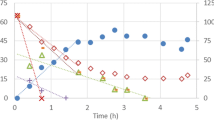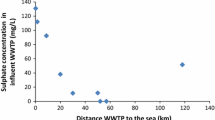Abstract
Pollution by inorganic and organic sulphur compounds is increasing and, because of the many environmental hazards associated with these compounds (e.g. toxicity, acidification of rain and freshwater, increase of COD, the greenhouse effect), must be taken seriously. There is a wide variety of sulphur oxidizing bacteria available in nature, and these can be used for the effective control of such pollution. The best way to break the sulphur cycle is to stop it at sulphur which, being insoluble, can be easily recovered (e.g.SO4 2- → S2- → S0). (Eco)physiological knowledge about the sulphur oxidizing bacteria has proved very useful in the prediction of the performance of sulphur oxidizing communities in actual wastewater treatment systems. Appropriate reactor design, based on this type of study, is essential if such bacterial communities are to function efficiently, especially when toxic sulphides must be treated. This paper reviews the natural and anthropogenic sources of sulphur pollution, its consequences and possible solutions.
Similar content being viewed by others
References
Beudeker RF, Gottschal JC & Kuenen JG (1982) Reactivity versus flexibility in thiobacilli. Antonie van Leeuwenhoek 48: 39–51
Bos P (1991) Microbial desulfurization of coal: a feasible process. In: Hecq W & Crine M (Eds) Microbial Processes for Heavy Metal Recovery (pp 63–78). University de Liège
Bos P & Kuenen JG (1989) Microbial treatment of coal. In: Brierley C & Ehrlich H (Eds) Microbial Metal Recovery (pp 343–377). McGraw Hill Book Company, New York
Bos P & Kuenen JG (1990) Microbial treatment of coal. In: Erlich H & Brierley C (Eds) Microbial Mineral Recovery (pp 344–377). McGraw-Hill Book Company, New York
Bos P, Huber TF, Luyben KChAM & Kuenen JG (1988) Feasibility of a Dutch process for microbial desulphurization of coal resources. Conservation and Recycling 1: 279–291
Bos P, Boogerd FC & Kuenen KG (1993) Microbial desulfurization of coal. In: Mitchell R (Ed) New Concepts in Environmental Microbiology. John Wiley & Sons, Chichester (in press)
Brierly CL (1982) Microbiological mining. Scientific American 247 (August): 42–51
Buisman CJN (1989) Biotechnological sulphide removal with oxygen. PhD Thesis, Agricultural University of Wageningen
Butlin KR & Postgate JR (1954) The microbiological formation of sulphur in Cyrenaican lakes. In: Cloudsley-Thompson J (Ed) Biology of Deserts (pp 112–122). Institute of Biology, London
de Zwart JMM & Kuenen JG (1992), C1 cycle of sulfur compounds. Biodegradation 3: 37–59
de Bont JAM, van Dijken JP & Harder W (1981) Dimethyl sulphoxide and dimethyl sulphide as a carbon, sulphur and energy source for growth of Hyphomicrobium S. J. Gen. Microbiol. 127: 315–323
Diks RM & Ottengraf SP (1991) Process engineering aspects of biological waste gas purification. In: Verachtert H & Verstraete W (Eds) Environmental Biotechnology 1991 (pp 353–367). European Federation of Biotechnology
Gommers PJF & Kuenen JG (1988) Thiobacillus strain Q, a chemolithoheterotrophic sulphur bacterium. Arch. Microbiol. 150: 117–125
Gommers PJF, Bijleveld W, Zuijderwijk FJM & Kuenen JG (1988) Simultaneous sulfide and acetate oxidation in a denitrifying fluidized bed reactor-II. Measurements of activities and conversion. Water Res. 22: 1085–1092
Gottschal JC, de Vries S & Kuenen JG (1979) Competition between the facultatively chemolithotrophic Thiobacillus A2, and obligately chemolithoptrophic Thiobacillus and a heterotrophic spirillum for inorganic and organic substrates. Arch. Microbiol. 121: 241–249
Gottschal JC, Nanninga HJ & Kuenen JG (1981) Growth of Thiobacillus A2 under alternating growth conditions in the chemostat. J. Gen. Microbiol. 126: 85–96
Isakson ISA (1987) Is the oxidizing capacity of the atmosphere changing? In: Rowland FS & Isaksen ISA (Eds) The Changing Atmosphere (pp 141–158). John Wiley & Sons, Chichester
Jorgensen BB (1982) Ecology of the bacteria of the sulphur cycle with special reference to anoxic-oxic interface environments. Philosophical Transactions of the Royal Society of London B 298: 543–561
Kanagawa T & Kelly DP (1986) Breakdown of dimethyl sulphide by mixed cultures and by Thiobacillus thioparus. FEMS Microbiol. Lett. 34: 13–19
Kanagawa T & Mikami E (1989) Removal of methanethiol, dimethyl sulfide, dimethyl disulphide and hydrogen sulfide from contaminated air by Thiobacillus thioparus TK-m. Appl. Environ. Microbiol. 55: 555–558
Kelly DP & Harrison AP (1989) The Genus Thiobacillus. In: Staley JT, Bryant MP, Pfennig N & Holt JG (Eds) Bergey's Manual of Systematic Bacteriology 3 (pp 1842–1858). Williams & Wilkins, Baltimore
Kuenen JG (1989) Colorless sulfur bacteria. In: Staley JT, Bryant MP, Pfenning N & Holt JG (Eds) Bergey's Manual of Systematic Bacteriology 3 (pp 1834–1837). Williams & Wilkins, Baltimore
Kuenen JG & Bos P (1989) Habitats and ecological niches of chemolitho(auto)trophic bacteria In: Schlegel HG & Bowien B (Eds) Autotrophic Bacteria (pp 53–80). Brock/Springer Series in Contemporary Bioscience, Science Tech. Publ., Madison, WI, Springer-Verlag, Berlin
Kuenen JG, Robertson LA & van Gemerden H (1985) Microbial interactions among aerobic and anaerobic sulfur-oxidizing bacteria. Adv. Microb. Ecology 8: 1–60
Kuenen JG, Robertson LA & Tuovinen OH (1992) The colourless sulphur bacteria In: Balows A, Truper HG, Dworkin M, Harder W & Schlefer KH (Eds) The Prokaryotes, Vol III (pp 2636–2657). Springer-Verlag, New York
Lane DJ, Harrison AP, Stahl DA, Pace B, Giovannoni SJ, Olsen GJ, Heller DJ & Pace NR (1992) Evolutionary relationships among sulfur and iron oxidizing eubacteria. J. Bacteriol. 174: 269–278
Legrand MR & Delmas RJ (1987) A 220-year continuous record of volcanic H2SO4 in the Antarctic ice sheet. Nature 327: 671–676
Lein AYu (1983) The sulphur cycle in the lithosphere, part II, cycling. In: Ivanov MV & Freney JR (Eds) The Global Biogeochemical Sulphur Cycle (pp 95–128). John Wiley, Chichester
Nanninga HJ (1987) Sulfate reduction and fermentation of amino acids in industrial waste water. PhD Thesis, University of Groningen, The Netherlands
Postgate JR (1982) Economic importance of sulphur bacteria. Philosophical Transactions of the Royal Society of London B 298: 583–600
Ramanathan V (1987) the radiative and climatic consequences of the changing atmospheric concentrations of trace gases. In: Rowland FS & Isaksen ISA (Eds) The Changing Atmosphere (pp 159–186). John Wiley & Sons, Chichester
Robertson LA & Kuenen JG (1984) Anaerobic and aerobic denitrification by sulphide oxidizing bacteria from waste water. In: van den Brink WJ (Ed) Anaerobic Waste Water Treatment (pp 3–12). AWWT Symposium Secretariat (pubs)
Robertson LA & Kuenen JG (1992) Aerobic sulphur oxidizing bacteria. In: Balows A, Truper HG, Dworkin M, Harder W & Schlefer KH (Eds) The Prokaryotes, Vol I (pp 385–413). Springer-Verlag, New York
Ryaboshapko AG (1983) The atmospheric sulphur cycle. In: Ivanov MV & Freney JR (Eds) The Global Biogeochemical Sulphur Cycle (pp 203–277). John Wiley, Chichester
Stauffer BR & Neftel A (1987) What have we learned from the ice cores about the atmospheric changes in the concentrations of nitrous oxide, hydrogen peroxide and other trace species? In: Rowland FS & Isaksen ISA (Eds) The Changing Atmosphere (pp 63–78). John Wiley & Sons, Chichester
Stefess GC & Kuenen JG (1989) Factors influencing elemental sulphur production from sulphide or thiosulphate by autotrophic thiobacilli. Forum Microbiologie 12: 92
Suylen GMH (1988) Microbial metabolism of dimethyl sulphide and related compounds. PhD Thesis, Delft University of Technology, The Netherlands
Suylen GMH & Kuenen JG (1986) Chemostat enrichment and isolation of Hyphomicrobium EG. A dimethyl-sulphide oxidizing methylotroph and reevaluation of Thiobacillus MS1. Antonie van Leeuwenhoek 52: 281–293
Suylen GMH, Stefess GC & Kuenen JG (1986) Chemolithotrophic potential of a Hyphomicrobium species, capable of growth on methylated sulphur compounds. Arch. Microbiol. 146: 192–198
Tanji Y, Kanagawa T & Mikami E (1989) Removal of dimethyl sulfide, methyl mercaptan and hydrogen sulfide by immobilized Thiobacillus thioparus TK-m. Journal of Fermentation and Bioengineering 67: 280–285
WHO (1984a) Guidelines for drinking water quality. Vol. 1. Recommendations. Pubs WHO, Geneva
WHO (1984b) Guidlines for drinking water quality. Vol 2. Health criteria and other supporting information. Pubs WHO, Geneva
Soese CR (1991) Prokaryote systematics: the evolution of a science. In: Balows A, Truper HG, Dworkin M, Harder W & Schlefer KH (Eds) The Prokaryotes, Vol I (pp 3–18). Springer-Verlag, New York
Author information
Authors and Affiliations
Rights and permissions
About this article
Cite this article
Kuenen, J.G., Robertson, L.A. The use of natural bacterial populations for the treatment of sulphur-containing wastewater. Biodegradation 3, 239–254 (1992). https://doi.org/10.1007/BF00129086
Issue Date:
DOI: https://doi.org/10.1007/BF00129086




